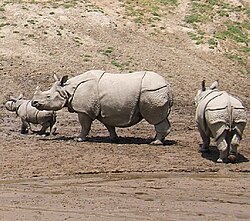インドサイ属
| インドサイ属 | ||||||||||||||||||||||||||||||
|---|---|---|---|---|---|---|---|---|---|---|---|---|---|---|---|---|---|---|---|---|---|---|---|---|---|---|---|---|---|---|
 インドサイ
| ||||||||||||||||||||||||||||||
| 分類 | ||||||||||||||||||||||||||||||
| ||||||||||||||||||||||||||||||
| 学名 | ||||||||||||||||||||||||||||||
| Rhinoceros Linnaeus, 1758 | ||||||||||||||||||||||||||||||
| タイプ種 | ||||||||||||||||||||||||||||||
| Rhinoceros unicornis Linnaeus, 1758 | ||||||||||||||||||||||||||||||
| 種 | ||||||||||||||||||||||||||||||
|
インドサイ属 (Rhinoceros) は、一角のサイが含まれる属である。1758年にカール・フォン・リンネが分類した[1]。インドサイとジャワサイの2つの種を含む。どちらの種も絶滅危惧種であるが、特にジャワサイはジャワ島にわずか60頭が生息するのみで、大型哺乳類としては最も絶滅に近い種の1つである。'rhinoceros'という言葉は、ギリシャ語で「鼻の角」を意味する言葉に由来する。
分類[編集]
- インドサイ (R. unicornis Linnaeus, 1758[1]) - インド亜大陸に生息。
- ジャワサイ (R. sondaicus Desmarest, 1822[2]) - 東南アジアに生息。
- †R. sivalensis Falconer and Cautley, 1846 - 鮮新世から前期更新世にインド亜大陸北部(シワリク丘陵)に生息した。
- †R. platyrhinus Falconer and Cautley, 1847 - 前期更新世から前期チバニアンにインド亜大陸シワリク丘陵に生息した。属で最も大きな種[3]。
- †R. sinensis Owen, 1870[4] - 更新世の中国のサイ化石に加え、スマトラサイ属やステファノリヌス属の様々な種のサイを含むとしてゴミ箱分類群[5]として使用される[6]が、R. sinensisとされる化石が別種の可能性もある[3]。
前期チバニアンのフィリピンに生息した"Rhinoceros" philippinensisや前期チバニアンの台湾に生息した"Rhinoceros" sinensis hayasakaiは、インドサイ属に近縁のネソリヌス属に移された[7]。一方、前期更新世の中国南部に生息したRhinoceros fusuiensis Yan et al. 2014[8]はスマトラサイ属に移された[7][9]。
語源[編集]
Rhinocerosという語は、古代ギリシャ語で鼻を意味する ῥίς (rhis)と動物の角を意味するκέρας (keras)を組み合わせて作られた言葉である[10][11]。
出典[編集]
- ^ a b Linnæus, C. (1758). “Rhinoceros unicornis”. Caroli Linnæi Systema naturæ per regna tria naturæ, secundum classes, ordines, genera, species, cum characteribus, differentiis, synonymis, locis. Holmiae: Salvius. p. 56
- ^ Desmarest, A. G. (1822). “Rhinocéros des Îles de La Sonde”. Mammalogie, ou, Description des espèces de mammifères. 2. Paris: Mme Agasse. pp. 399–400
- ^ a b Pandolfi, Luca; Maiorino, Leonardo (2016-02-06). “Reassessment of the largest Pleistocene rhinocerotine Rhinoceros platyrhinus (Mammalia, Rhinocerotidae) from the Upper Siwaliks (Siwalik Hills, India)”. Journal of Vertebrate Paleontology 36 (2): e1071266. Bibcode: 2016JVPal..36E1266P. doi:10.1080/02724634.2015.1071266. ISSN 0272-4634.
- ^ Schepartz, L. A.; Miller-Antonio, S. (2010). “Taphonomy, life history, and human exploitation of Rhinoceros sinensis at the Middle Pleistocene site of Panxian Dadong, Guizhou, China”. International Journal of Osteoarchaeology 20 (3): 253–268. doi:10.1002/oa.1025.
- ^ Antoine, Pierre-Olivier (March 2012). “Pleistocene and Holocene rhinocerotids (Mammalia, Perissodactyla) from the Indochinese Peninsula” (英語). Comptes Rendus Palevol 11 (2–3): 159–168. Bibcode: 2012CRPal..11..159A. doi:10.1016/j.crpv.2011.03.002.
- ^ Tong, Hao-wen (November 2012). “Evolution of the non-Coelodonta dicerorhine lineage in China” (英語). Comptes Rendus Palevol 11 (8): 555–562. Bibcode: 2012CRPal..11..555T. doi:10.1016/j.crpv.2012.06.002.
- ^ a b Antoine, P.-O.; Reyes, M. C.; Amano, N.; Bautista, A. P.; Chang, C.-H.; Claude, J.; De Vos, J.; Ingicco, T. (2021). “A new rhinoceros clade from the Pleistocene of Asia sheds light on mammal dispersals to the Philippines”. Zoological Journal of the Linnean Society 194 (2): 416–430. doi:10.1093/zoolinnean/zlab009.
- ^ Yan, Yaling; Wang, Yuan; Jin, Changzhu; Mead, Jim I. (December 2014). “New remains of Rhinoceros (Rhinocerotidae, Perissodactyla, Mammalia) associated with Gigantopithecus blacki from the Early Pleistocene Yanliang Cave, Fusui, South China” (英語). Quaternary International 354: 110–121. Bibcode: 2014QuInt.354..110Y. doi:10.1016/j.quaint.2014.01.004.
- ^ Pandolfi, Luca (2023-01-19). “Reassessing the phylogeny of Quaternary Eurasian Rhinocerotidae” (英語). Journal of Quaternary Science 38 (3): 291–294. Bibcode: 2023JQS....38..291P. doi:10.1002/jqs.3496. hdl:11563/163194. ISSN 0267-8179.
- ^ Liddell, H. G. & Scott, R. (1940). “ῥίς”. A Greek-English Lexicon (Revised and augmented ed.). Oxford: Clarendon Press
- ^ Liddell, H. G. & Scott, R. (1940). “κέρᾳ”. A Greek-English Lexicon (Revised and augmented ed.). Oxford: Clarendon Press
